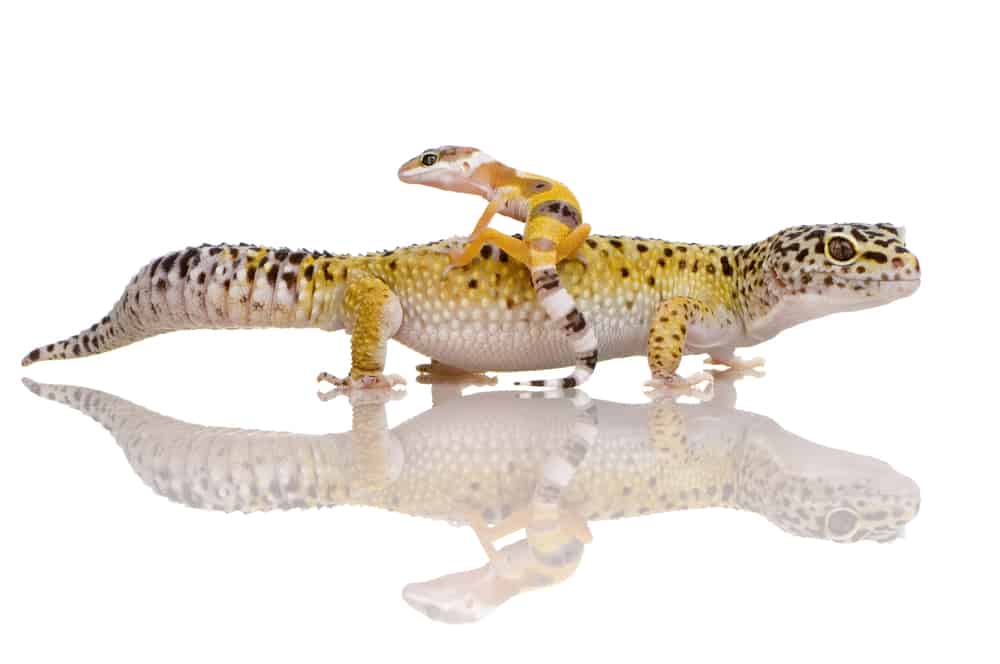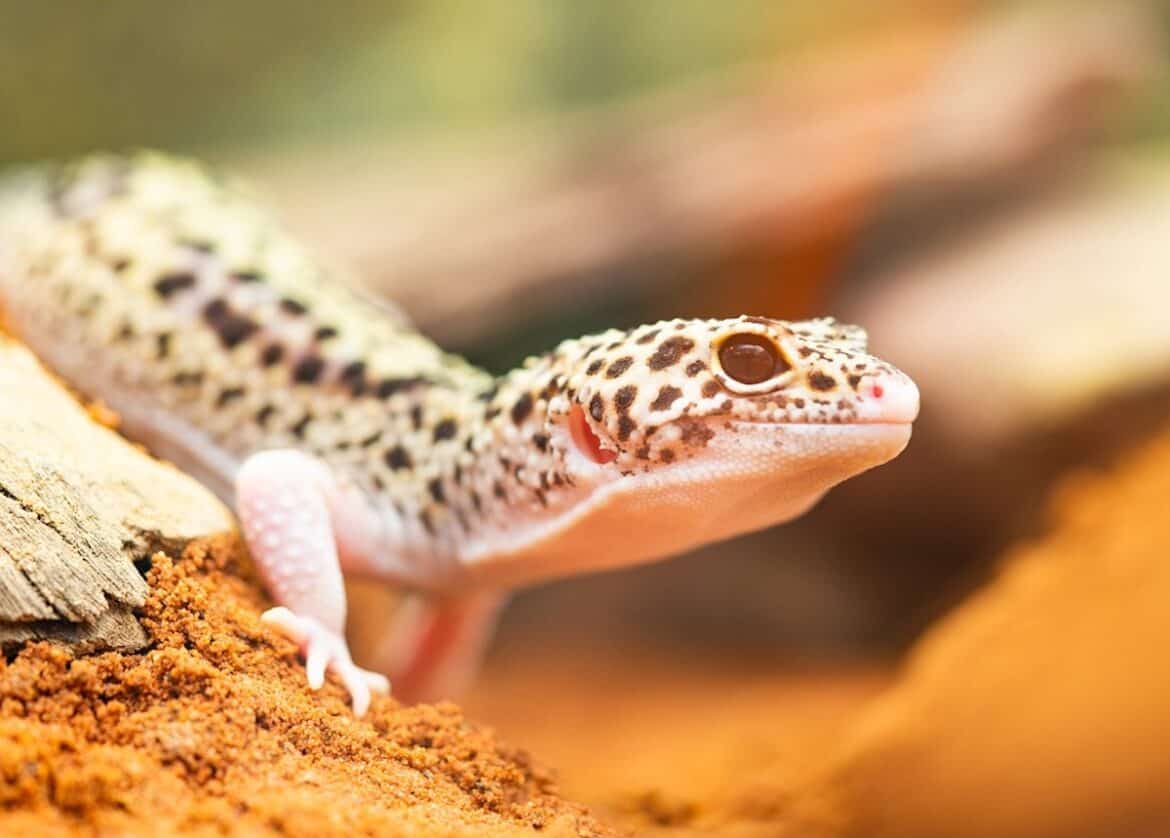Leopard geckos have spiked in popularity as pets in the last decade. With a docile demeanor and a smiley little face, it’s no wonder they’ve taken the pet world by storm.
Even some people who shy away from all things reptilian agree that these little cuties are an exception to the “I don’t want that thing in my house” rule.
Whether you’re on the fence about adopting a leopard gecko because you’re not sure how big they get or you’re already an owner who wants to be as prepared as possible, you’re probably wondering:
How fast do leopard geckos grow? Leopard geckos reach maturity at around 18-20 months old. As hatchlings, they weigh around 2-4 grams (3-4″) and quickly grow to be 15-25 grams (4-5″) in the course of a month. When they settle into adulthood and sexual maturity, they will weigh 33-35 grams (8-12″). Females are typically smaller.
In this growth guide, we’ll explain the development stages of leopard geckos and help you prepare for their rapid change in size, diet, and other needs.
When Is a Leopard Gecko Considered Full-Grown?

If you get your leopard gecko from a pet store, you’re likely to adopt one while it’s teeny-tiny, probably around the age of 6 weeks old (4-5″ long).
However, it won’t take long for your little lizard to grow up into adulthood. At around 18-20 months old, leopard geckos reach their full weight and size.
Depending on whether they are male or female, leopard geckos grow to be around 8-12″ long from nose to tail.
Females tend to be on the smaller end of the scale.
However, leopard geckos can reach sexual maturity at different ages, and this is more dependent on their weight than their age. Once they reach a weight of 35 grams, they are able to be bred.
Luckily, if you’re looking for an animal companion who won’t take up too much space in your tiny apartment, these guys stay pretty small and manageable as far as reptiles go. They’re also known for being quite easy to handle and generally very docile.
The Stages of Leopard Gecko Development
If you’ve ever seen a leopard gecko hatchling, you know how absolutely adorable they are when they’re small enough to hold with one finger. Sadly, they don’t stay this way for long, but they do stay just as cute.
As they grow, they even begin to develop new patterns, colors, and spots after each shed. Each leopard gecko is unique and they come in a wide variety of colors (or morphs), including yellow, orange, black, and white.
Leopard geckos go through three stages of development, during which they not only start shedding and developing new patterns but also lose their first set of teeth, fill out more, and begin the process of brumation.
Brumation is a reptilian form of hibernation that begins when they are around a year old, during which they will hide for long periods of time, stop eating as much, and appear more lethargic. Don’t worry; this is normal behavior and your gecko will be back to normal soon.
There are three stages of leopard gecko development:
- Hatchling – This is the stage immediately after being hatched to around their adoptable age, which is usually 6 weeks.
- Juvenile – Leopard geckos will be considered juveniles from their adoptable age to around 10-12 months old.
- Adult – Leopard geckos are full-grown at around 18-20 months.
Below, we’ve put together a few handy charts to refer back to as a guideline of your gecko’s development. Keep in mind that each individual animal is different and may end up a bit larger or smaller than these average estimations.
Leopard Gecko Growth Chart – Weight
| Age | Weight |
|---|---|
| Hatchling | 2-4 grams |
| 1 month | 15-25 grams |
| 2-3 months | 20-30 grams |
| 4-5 months | 25-35 grams |
| 6-7 months | 30-40 grams |
| 8-9 months | 35-45 grams |
| 10-12 months | 40-50 grams |
| 18-20 months | 60-90 grams |
Leopard Gecko Growth Chart – Length
| Age | Length |
|---|---|
| Hatchling | 3 inches |
| 1 month | 4-5 inches |
| 2-3 months | 5-5.5 inches |
| 4-5 months | 5.5-6 inches |
| 6-7 months | 6-6.5 inches |
| 8-9 months | 7-7.5 inches |
| 10-12 months | 7.5-8 inches |
| 18-20 months | 8-12 inches |
How Long Do Leopard Geckos Live?
Unfortunately, it’s a pretty well-known fact in the animal lover community that smaller animals don’t tend to have very long lifespans. But don’t fret about crossing off all your little buddy’s bucket list items just yet because leopard geckos can live up to 20 years in captivity.
This means that if you let your son or daughter adopt a leopard gecko in middle school, that little guy might just be around to watch them graduate not only high school but college, too! But with great lifespans come great responsibility.
As the proud owner of a leopard gecko, it’s your job to make sure their needs are met so they will be happy and healthy and can live their life to the fullest. Just like any other pet, you’ll need to seriously consider whether you’re up to the challenge of caring for these small critters before you adopt one.
What Size Tank Does a Leopard Gecko Need?
Like we’ve mentioned, leopard geckos don’t actually get very big compared to other reptiles. At the very least, the general rule is to keep a leopard gecko in a long 20-gallon tank, or an additional 10 gallons of space per extra gecko you intend to house.
You may be thinking it’s a good idea to start off with a small tank and buy a larger one later, but since leopard geckos grow so fast, it’s better to start off with a larger tank that they can grow into.
The dimensions should be around 30 x 12 x 12″ for a single leopard gecko. You may be wondering whether there’s such a thing as a tank that’s too large for them, and the answer is actually yes.
Some reptiles can be overwhelmed by having too much space that they can’t be familiarized with at all times and this can cause stress. Therefore, it’s best to stick with a slightly smaller tank with ample room for your gecko’s favorite hides.
If you’re looking for a suitable tank for your leopard gecko, this one is our personal favorite.
What Do Growing Leopard Geckos Eat?
From the time leopard gecko hatchlings first emerge into the world, they are equipped with everything they need to hunt tiny bugs and critters of all kinds. It’s best to start hatchlings off with mealworms and small crickets. Later on, they should graduate from small crickets to larger ones or to a larger quantity.
For your convenience, we’ve put together a helpful chart detailing how much to feed your leopard gecko and how often.
Leopard Gecko Feeding Chart
| Size | Quantity | Frequency |
|---|---|---|
| Hatchling | 4-6 small insects | Once a day |
| 4 inches | 7-8 small insects | Once a day |
| 5 inches | 9-10 small insects | Once a day |
| 6 inches | 11-12 small insects | Once a day |
| 7 inches | 13-14 small insects | Once every other day |
| 8 inches | 15-16 small insects or 4-5 large insects | Once every other day |
| 9-12 inches | 20 small insects or 6-7 large insects | Once every other day |
Don’t worry if your leopard gecko isn’t eating as much as you expect it to; your gecko will set the pace for its feeding.
However, it is possible to overfeed your gecko and you should be careful to watch their weight to make sure they are eating a healthy amount. If your gecko’s tail is fatter than its neck, it is overweight.
Tip: If you are not lighting your leopard gecko’s tank with UVB lighting, make sure to supplement their diet with vitamin D3 and calcium powders. This will help prevent metabolic bone disease, which is a common occurrence in reptiles who don’t get enough of these vitamins.
As always, however, it’s a good idea to check with a vet before adding to your pet’s diet.
Related Questions
I hope this article has answered all the questions you had about leopard gecko growth. We’ve gathered a few questions below for your consideration that may be helpful to you as well. Check them out!
Can You Feed Leopard Geckos Only Crickets or Mealworms?
In the wild, leopard geckos can’t really afford to be picky; they eat what they can find, so naturally, they end up eating all sorts of little creepy crawlies. You may be thinking your own domesticated buddy will appreciate having only his favorite meal all the time, but this isn’t really the case.
Leopard geckos need a bit more variation in their diet, as mealworms are deficient in certain vitamins that crickets are rich in, and vice versa. Therefore, offering your gecko a variety of options is always a better idea.
Of course, you may also want to invest in some calcium and vitamin D3 supplement powder so your gecko gets all the goodies they need to live a long and happy life.
At What Age Can Leopard Geckos Be Adopted?
Leopard geckos are generally solitary creatures that have no need to take care of their young. The mother buries her eggs to protect them as best she can and moves on. This means hatchlings are pretty self-sufficient from the get-go.
Most pet stores sell leopard geckos at around the age of 6 weeks old. By this time, the hatchlings have learned to eat and aren’t as delicate as when they’ve just been hatched.
Are Leopard Geckos Born With Teeth?
Leopard geckos are born with 100 teeth, which continue to fall out and be replaced throughout their lives every 3-4 months. This is the reason they are able to eat small crickets and meal worms as young hatchlings.
Do Leopard Geckos Lay Eggs?
Yes, leopard geckos lay eggs and are hatched from eggs. Oblong shaped and about the length of a quarter, these eggs have a leathery shell. As we mentioned in the answer above, the mother lays her clutch, buries them for protection, and moves on.
What Are Some Tips for Keeping Leopard Geckos?
If you’re new to the wonderful world of leopard geckos, you’re likely looking for all the best tips and tricks for keeping your reptile friend happy and healthy.
We suggest watching this helpful video by the Elle’s Reptiles channel on YouTube for some great tips for beginner leopard gecko keepers.
Up Next: Do Leopard Geckos Make Noise?
